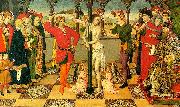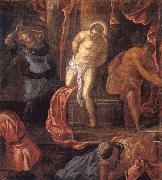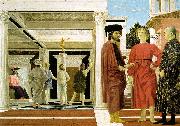
Oil On
Canvas, Real Flavor of Old Masters
|
Hugo van der Goes
|
|||
|
|
|||
| 1440-1482 Flemish Hugo van der Goes Galleries Hugo became a member of the painters' guild of Ghent as a master in 1467. In 1468 he was involved in the decoration of the town of Bruges in celebration of the marriage between Charles the Bold and Margaret of York and he provided heraldic decorations for Charles's joyeuse entr??e to Ghent in 1469 and again in 1472. He was elected dean of the Ghent guild in 1473 or 1474. In 1475, or some years later, Hugo entered Rooklooster, a monastery near Brussels belonging to the Windesheim Congregation, and professed there as a frater conversus. He continued to paint, and remained at Rooklooster until his death in 1482 or 1483. In 1480 he was called to the town of Leuven to evaluate the Justice Scenes left unfinished by the painter Dieric Bouts on his death in 1475. Shortly after this, Hugo, returning with other members of his monastery from a trip to Cologne, fell into a state of suicidal gloom, declaring himself to be damned. After returning to Rooklooster, Hugo recovered from his illness, and died there. His time at Rooklooster is recorded in the chronicle of his fellow monk, Gaspar Ofhuys. A report by a German physician, Hieronymus M??nzer, from 1495, according to which a painter from Ghent was driven to melancholy by the attempt to equal the Ghent Altarpiece, may refer to Hugo. His most famous surviving work is the Portinari Triptych (Uffizi, Florence), an altarpiece commissioned for the church of San Egidio in the hospital of Santa Maria Nuova in Florence by Tommaso Portinari, the manager of the Bruges branch of the Medici Bank. The triptych arrived in Florence in 1483, apparently some years after its completion by van der Goes. The largest Netherlandish work that could be seen in Florence, it was greatly praised. Giorgio Vasari in his Vite of 1550 referred to it as by "Ugo d'Anversa" ("Hugo of Antwerp"). This the sole documentation for its authorship by Hugo; other works are attributed to him based on stylistic comparison with the altarpiece. Hugo appears to have left a large number of drawings, and either from these or the paintings themselves followers made large numbers of copies of compositions that have not survived from his own hand. A drawing of Jacob and Rachel preserved at Christ Church, Oxford is thought to be a rare surviving autograph drawing. | |||
|
|
|||
|
|
Flagellation of Christ Hugo van der Goes16.jpg Painting ID:: 10055 Visit European Gallery |
1450s Wood,106x210cm Louvre, Paris | |
Height Width |
INS/CM |
||
|
X |
|
||
|
|
|||
|
Tintoretto
|
|||
|
|
|||
| Italian Mannerist Painter, ca.1518-1594 His father was a silk dyer (tintore); hence the nickname Tintoretto ("Little Dyer"). His early influences include Michelangelo and Titian. In Christ and the Adulteress (c. 1545) figures are set in vast spaces in fanciful perspectives, in distinctly Mannerist style. In 1548 he became the centre of attention of artists and literary men in Venice with his St. Mark Freeing the Slave, so rich in structural elements of post-Michelangelo Roman art that it is surprising to learn that he had never visited Rome. By 1555 he was a famous and sought-after painter, with a style marked by quickness of execution, great vivacity of colour, a predilection for variegated perspective, and a dynamic conception of space. In his most important undertaking, the decoration of Venice's Scuola Grande di San Rocco (1564 C 88), he exhibited his passionate style and profound religious faith. His technique and vision were wholly personal and constantly evolving. | |||
|
|
|||
|
|
Flagellation of Christ new12/Tintoretto-655362.jpg Painting ID:: 39603 Visit European Gallery |
mk150 c.1585/90 Canvas 118.3x106cm | |
Height Width |
INS/CM |
||
|
X |
|
||
|
|
|||
|
SODOMA, Il
|
|||
|
|
|||
| Italian High Renaissance Painter, 1477-1549 Sienese painter, whose real name was Giovanni Antonio Bazzi. Born in Vercelli, Piedmont, he went to Rome c.1508. Commissioned by Pope Julius II, he painted frescoes in the Camera della Segnatura in the Vatican. Raphael's frescoes afterward replaced most of his work there. For Agostino Chigi in the Farnesina Villa, Sodoma painted two frescoes, The Marriage of Alexander and Alexander in the Tent of Darius. In Siena and its vicinity he produced many works, executed in a saccharine style. | |||
|
|
|||
|
|
Flagellation of Christ new16/SODOMA, Il-673652.jpg Painting ID:: 43605 Visit European Gallery |
c. 1510 Oil on wood, 36,5 x 70,3 cm | |
Height Width |
INS/CM |
||
|
X |
|
||
|
|
|||
|
Piero della Francesca
|
|||
|
|
|||
| Italian Early Renaissance Painter, ca.1422-1492 Italian painter and theorist. His work is the embodiment of rational, calm, monumental painting in the Italian Early Renaissance, an age in which art and science were indissolubly linked through the writings of Leon Battista Alberti. Born two generations before Leonardo da Vinci, Piero was similarly interested in the scientific application of the recently discovered rules of perspective to narrative or devotional painting, especially in fresco, of which he was an imaginative master; and although he was less universally creative than Leonardo and worked in an earlier idiom, he was equally keen to experiment with painting technique. Piero was as adept at resolving problems in Euclid, whose modern rediscovery is largely due to him, as he was at creating serene, memorable figures, whose gestures are as telling and spare as those in the frescoes of Giotto or Masaccio. His tactile, gravely convincing figures are also indebted to the sculpture of Donatello, an equally attentive observer of Classical antiquity. In his best works, such as the frescoes in the Bacci Chapel in S Francesco, Arezzo, there is an ideal balance between his serene, classical compositions and the figures that inhabit them, the whole depicted in a distinctive and economical language. In his autograph works Piero was a perfectionist, creating precise, logical and light-filled images (although analysis of their perspective schemes shows that these were always subordinated to narrative effect). However, he often delegated important passages of works (e.g. the Arezzo frescoes) to an ordinary, even incompetent, assistant. | |||
|
|
|||
|
|
Flagellation of Christ new20/Piero della Francesca-387346.jpg Painting ID:: 58851 Visit European Gallery |
Flagellation of Christ Piero della Francesca, probably 1455?C1460 Oil and tempera on panel 58.4 ?? 81.5 cm Galleria Nazionale delle Marche, Urbino | |
Height Width |
INS/CM |
||
|
X |
|
||
|
|
|||










